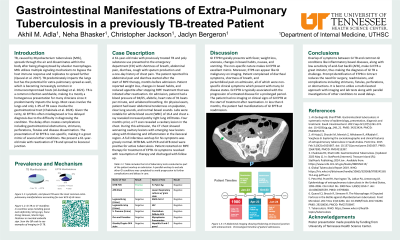Tuesday Poster Session
Category: Colon
P3780 - Gastrointestinal Manifestations of Extra-Pulmonary Tuberculosis in a Previously TB-Treated Patient
Tuesday, October 29, 2024
10:30 AM - 4:00 PM ET
Location: Exhibit Hall E

Has Audio

Akhil Adla, DO
University of Tennessee Health Science Center
Memphis, TN
Presenting Author(s)
Akhil Adla, DO, Neha Bhaskar, MD, Christopher D.. Jackson, MD, Jaclyn Bergeron, MD
University of Tennessee Health Science Center, Memphis, TN
Introduction: Primary manifestation of tuberculosis (TB) is pulmonary however, TB is known to disseminate throughout the body. Extrapulmonary tuberculosis (EPTB) has varying prevalence around the world. Per World Health Organization Report (WHO), in 2018, EPTB accounted for 15% of TB cases worldwide. Although EPTB cases are the minority of TB cases, EPTB has higher rates of complications, especially with gastrointestinal EPTB (GI EPTB). GI EPTB only accounted for 1-3% of all TB cases. GI EPTB typically presents with non-specific symptoms, making diagnosis a challenge. We present a rare case of a 61-year-old male with recurrence of TB and rapid progression to GI EPTB.
Case Description/Methods: A 61-year-old male with previously treated TB and poly substance use presented to the emergency department (ED) with shortness of breath, abdominal pain, diarrhea, cough with sputum production and a one-day history of chest pain. The patient reported his abdominal pain and diarrhea started after the start of RIPE therapy, months before admission. On admission, patient had a blood pressure of 94/65, afebrile, heart rate of 91 beats per minute, and unlabored breathing. On physical exam, patient had lower abdominal tenderness on palpation, clear lung sounds, and normal bowel sounds. Labs were notable for white blood count (WBC) of 16.4 and chest x-ray revealed increased patchy right lung infiltrates. Four months prior, a CT scan revealed a cavitary lesion in the chest. MTB BAL with PCR was positive for active tuberculosis and was started on therapy. During this admission, the CT chest showed worsening cavitary lesions with emerging new lesions along with thickening and inflammation in the ileocecal region. The full infectious workup for his symptoms was grossly normal. MTB PCR was positive. Patient restarted on RIPE therapy for treatment of EPTB.
Discussion: GI ETPB typically presents with fever, weight loss, anorexia, changes in bowel habits, nausea, and vomiting. The non-specific nature makes GI EPTB an excellent mimic. Moreover, ETPB can appear like GI malignancy on imaging. Patient complained of diarrheal symptoms, shortness of breath, and periumbilical pain on admission, all of which were non-specific clinical symptoms. GI EPTB is typically associated with the progression of untreated disease for a prolonged period. The patient had no imaging or clinical signs of GI EPTB at the start of treatment after reactivation. In less than 6 months, the patient had manifestations of GI EPTB at readmission.
Note: The table for this abstract can be viewed in the ePoster Gallery section of the ACG 2024 ePoster Site or in The American Journal of Gastroenterology's abstract supplement issue, both of which will be available starting October 27, 2024.
Disclosures:
Akhil Adla, DO, Neha Bhaskar, MD, Christopher D.. Jackson, MD, Jaclyn Bergeron, MD. P3780 - Gastrointestinal Manifestations of Extra-Pulmonary Tuberculosis in a Previously TB-Treated Patient, ACG 2024 Annual Scientific Meeting Abstracts. Philadelphia, PA: American College of Gastroenterology.
University of Tennessee Health Science Center, Memphis, TN
Introduction: Primary manifestation of tuberculosis (TB) is pulmonary however, TB is known to disseminate throughout the body. Extrapulmonary tuberculosis (EPTB) has varying prevalence around the world. Per World Health Organization Report (WHO), in 2018, EPTB accounted for 15% of TB cases worldwide. Although EPTB cases are the minority of TB cases, EPTB has higher rates of complications, especially with gastrointestinal EPTB (GI EPTB). GI EPTB only accounted for 1-3% of all TB cases. GI EPTB typically presents with non-specific symptoms, making diagnosis a challenge. We present a rare case of a 61-year-old male with recurrence of TB and rapid progression to GI EPTB.
Case Description/Methods: A 61-year-old male with previously treated TB and poly substance use presented to the emergency department (ED) with shortness of breath, abdominal pain, diarrhea, cough with sputum production and a one-day history of chest pain. The patient reported his abdominal pain and diarrhea started after the start of RIPE therapy, months before admission. On admission, patient had a blood pressure of 94/65, afebrile, heart rate of 91 beats per minute, and unlabored breathing. On physical exam, patient had lower abdominal tenderness on palpation, clear lung sounds, and normal bowel sounds. Labs were notable for white blood count (WBC) of 16.4 and chest x-ray revealed increased patchy right lung infiltrates. Four months prior, a CT scan revealed a cavitary lesion in the chest. MTB BAL with PCR was positive for active tuberculosis and was started on therapy. During this admission, the CT chest showed worsening cavitary lesions with emerging new lesions along with thickening and inflammation in the ileocecal region. The full infectious workup for his symptoms was grossly normal. MTB PCR was positive. Patient restarted on RIPE therapy for treatment of EPTB.
Discussion: GI ETPB typically presents with fever, weight loss, anorexia, changes in bowel habits, nausea, and vomiting. The non-specific nature makes GI EPTB an excellent mimic. Moreover, ETPB can appear like GI malignancy on imaging. Patient complained of diarrheal symptoms, shortness of breath, and periumbilical pain on admission, all of which were non-specific clinical symptoms. GI EPTB is typically associated with the progression of untreated disease for a prolonged period. The patient had no imaging or clinical signs of GI EPTB at the start of treatment after reactivation. In less than 6 months, the patient had manifestations of GI EPTB at readmission.
Note: The table for this abstract can be viewed in the ePoster Gallery section of the ACG 2024 ePoster Site or in The American Journal of Gastroenterology's abstract supplement issue, both of which will be available starting October 27, 2024.
Disclosures:
Akhil Adla indicated no relevant financial relationships.
Neha Bhaskar indicated no relevant financial relationships.
Christopher Jackson indicated no relevant financial relationships.
Jaclyn Bergeron indicated no relevant financial relationships.
Akhil Adla, DO, Neha Bhaskar, MD, Christopher D.. Jackson, MD, Jaclyn Bergeron, MD. P3780 - Gastrointestinal Manifestations of Extra-Pulmonary Tuberculosis in a Previously TB-Treated Patient, ACG 2024 Annual Scientific Meeting Abstracts. Philadelphia, PA: American College of Gastroenterology.

